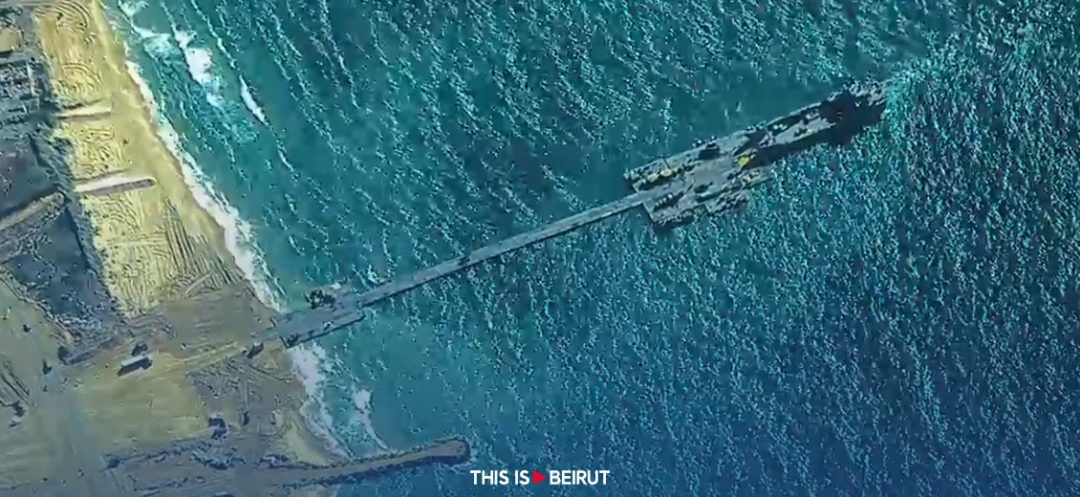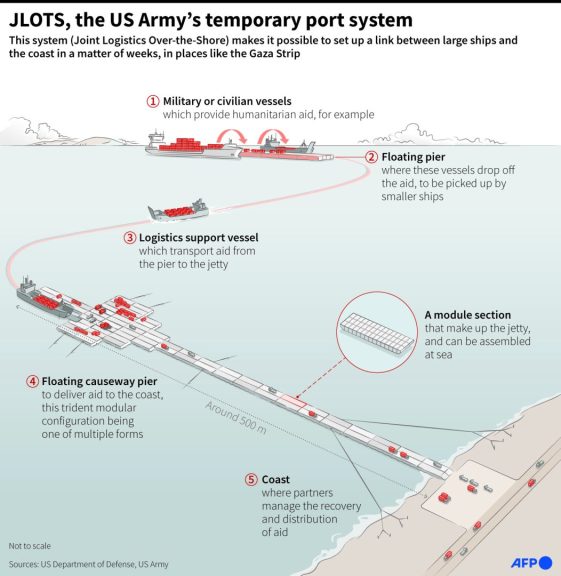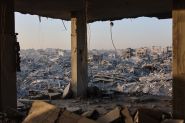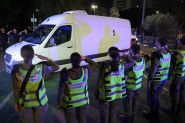- Home
- Middle East
- Fact Sheet for Gaza Floating Aid Pier

©Source : AFP/CENTCOM
“Today at approximately 9 AM (Gaza time), trucks carrying humanitarian assistance began moving ashore via a temporary pier in Gaza.” This is how United States Central Command (CENTCOM) announced the completion of a temporary aid assistance pier in Gaza on Friday.
US President Joe Biden had announced this maritime corridor of humanitarian assistance into Gaza during his State of the Union address in March, in a move seen as an attempt to calm critics within his own Democratic Party, as the November election looms ahead.
The pier was initially proposed as a way to supplement aid delivery to Gaza’s population, in dire need of food and supplies. However, with the ongoing incursion into Rafah, and the closing of all road crossings, this feat of military engineering may become the only entry point for aid into the besieged Gaza Strip.
Components
The pier is essentially an assembly of metal pieces built at sea, sitting close to water and that can take on various lengths depending on mission requirements. This capability known as Joint Logistics Over-the-Shore (JLOTS) has two components:
First, a floating offshore barge that is the first point of arrival for aid deliveries and is anchored off the coast of Gaza. The floating barge acts as a stable area to offload pallets from large commercial vessels onto smaller military vessels that can come closer to shore. These small vessels can carry between five and fifteen trucks of aid each.
The second component, in the shape of a trident pier, is a 550-meter causeway, anchored to the shore. The trucks are unloaded from the small vessels and driven from there to the beach.
To stab the trident pier into the beach, military bulldozers were used to dig a massive trench on the beach leading the pier to a water-filled entry point (a duck pond) for the pier to attach itself to the beach. After the duck pond was created, the pier was rammed 12 meters into the sand at 5-knot speed. At that point, buried anchors and tug vessels are used, and constantly maintained, to keep the pier in place for the trucks to roll on and off, safely.
“The pieces of the pier were loaded on the East Coast of the United States and transported 11,000 kilometers, and then assembled off the coast of Gaza” according to Vice Admiral Brad Cooper, the Deputy Commander of CENTCOM, in a May 15 press statement. Fourteen US and partner ships were used for this mission as well as 1,000 military personnel. Final assembly took place in the Israeli port of Ashdod and the vessel associated with the building moved on to Gaza. Construction was finalized last week, but weather conditions delayed the final maneuver until Thursday.
Ashore, Israeli military engineers guided the pier into place according to Vice Admiral Cooper. “Military engineers prepared the beach at Gaza and secured the temporary pier to the beach. They were specially trained for the mission by US Army engineers in the preceding weeks on a beach in Israel,” Cooper told reporters on Thursday.
 © AFP Source: US Department of Defense, US Army
© AFP Source: US Department of Defense, US ArmyOperational procedures
Aid starts in Cyprus where it is assembled, palletized and loaded onto cargo ships. The aid is inspected in Cyprus so it does not need to be checked and slowed down once it reaches Gaza shores.
Cyprus provides a hosting function including port facilities, logistics and organization “as part of a multinational coordination cell to include all the various players, which include not just the US but the United Kingdom, the European Union and the United Arab Emirates, just to name a few,” said Dan Diekhaus, USAID response director in a press briefing on May 16.
Aid then embarks on a trip of roughly 370 kilometers, a journey of about 15 hours. Once the ship arrives at the JLOTS, it is transferred by US military vessels to the causeway attached to the coast. From there, trucks deliver it to Gaza. “These trucks are driven by a third party down the causeway onto land and commodities are dropped off on land. These trucks then repeat the process over and over in that same loop,” according to Cooper. At no point do US troops have actual “boots on the ground,” which is code talk for no risk to army personnel.
Security on the beach is provided by the Israeli army. Once the aid is ashore, the UN and the World Food Program carry out delivery coordination and distribution inside Gaza. “These are two separate processes.”
Challenges
According to CENTCOM’s statement on Friday, “The pier is an ongoing multinational effort to deliver additional aid to Palestinian civilians in Gaza via a maritime corridor that is entirely humanitarian in nature.”
At this time, it is also the only available corridor for aid entering Gaza as all other crossings have been closed since the beginning of the Rafah incursion early last week.
However, the pier is unusable in bad weather, when waves are high or winds are fast.
Initially, the pier is expected to deliver 90 trucks worth of aid per day moving up to 150 per day once it reaches full capacity. Yet, according to international aid organizations, 500 trucks are needed every day.
Another downside is that every added step increases the cost of aid delivery notwithstanding the actual cost of the corridor, estimated at $320 million by the Pentagon.
A simpler and more cost-effective solution would be to open road crossings for trucks to enter the strip.
When asked by reporters, on May 16, how long the pier was to stay off the coast of Gaza, Deputy Pentagon Press Secretary Sabrina Singh said that she didn’t have a timeline. “It is designed to be temporary. This is not going to be a permanent way of getting aid into Gaza,” she said.
Today at approximately 9 a.m. (Gaza time), trucks carrying humanitarian assistance began moving ashore via a temporary pier in Gaza. No U.S. troops went ashore in Gaza. This is an ongoing, multinational effort to deliver additional aid to Palestinian civilians in Gaza via a… pic.twitter.com/Gdt9Scgq2y
— U.S. Central Command (@CENTCOM)Today at approximately 9 a.m. (Gaza time), trucks carrying humanitarian assistance began moving ashore via a temporary pier in Gaza. No U.S. troops went ashore in Gaza. This is an ongoing, multinational effort to deliver additional aid to Palestinian civilians in Gaza via a… pic.twitter.com/Gdt9Scgq2y
— U.S. Central Command (@CENTCOM) May 17, 2024
Read more




Comments